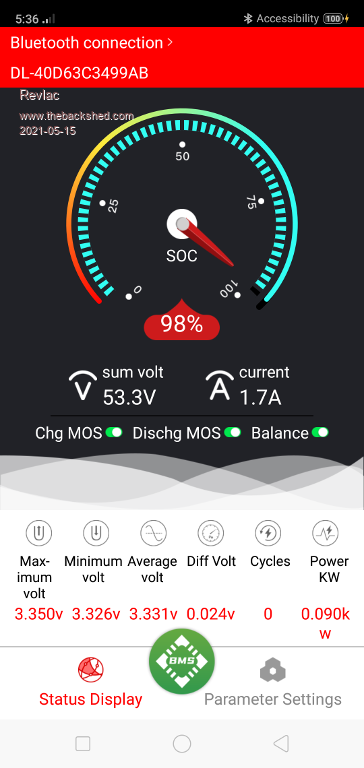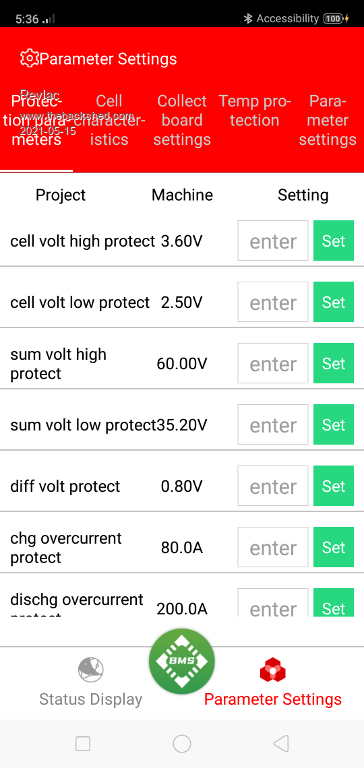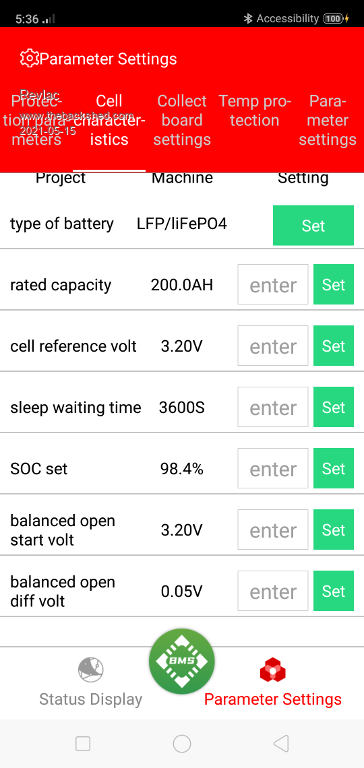
|

|
Forum Index : Electronics : Adding Lithium to lead
| Author | Message | ||||
renewableMark Guru Joined: 09/12/2017 Location: AustraliaPosts: 1678 |
Hi guys, this idea was brought up in another thread, but I thought it deserved it's own thread. Vid So if you were to add lifepo4 to a flooded battery that had an absorb of 57.6v then the lithium cells would be brought up to 3.6v per cell which is getting towards the top of their limit. Taking them to 3.55 would bring the battery up to 56.8v which is probably fine. Taking the cells to 3.5 would bring the battery up to 56v, probably getting a bit low for a flooded. BUT what if we use one of the new smart BMS from Daly? Here It looks like you could have the BMS set the upper charge limit of the battery, so if they were parralleled to a lead, then the lead will keep charging up to it's 57.6 and the smart BMS will cut off the charge to the lifepo4 at what you set it too. Is my understanding of this correct? Cheers Caveman Mark Off grid eastern Melb |
||||
| Davo99 Guru Joined: 03/06/2019 Location: AustraliaPosts: 1578 |
If you had the lead and the lipo connected as one bank, wouldn't you need Diodes between the Lipo and the lead to stop the lead charging the lipo through the connection ? Maybe I have the idea wrong? I also thought that 3.4 was better from a longevity POV for lipo? If you are using a separate BMS and the lipos are isolated from the lead by way of Diodes, then no need to push them I would think. |
||||
| Warpspeed Guru Joined: 09/08/2007 Location: AustraliaPosts: 4406 |
The key to this is very carefully matching the two battery voltages, and we are not limited to just using multiple twelve volt commercial batteries in series. With both fork lift batteries and Lithium, we can select multiples of individual cells, and no reason why an odd number of cells could not be used in either or both batteries to arrive at the ideal combination. I believe for this all to work as originally intended, both lead and lithium need to be connected permanently together and act as a single battery. As soon as you start using diode isolation, or contactors to connect/disconnect the two batteries for individual control, the original concept would be lost. I can see this being worth thinking about where space for the battery is very limited, such as a boat, or camper van. But for fixed off grid operation, I doubt if its really an economic solution. Perhaps just doubling up on the lead cells might provide more total battery capacity per dollar. Cheers, Tony. |
||||
Revlac Guru Joined: 31/12/2016 Location: AustraliaPosts: 1024 |
Hi Mark, I have been thinking of doing something similar with 2 different batteries LifePo4 and Lion's, battery charging voltage will be different but loaded working voltage will end up close after a short time. Trailing the Daly BMS ATM, they work Ok as a battery safety so far, Only gripe I have is the SOC meter drops a little percentage over time, I'm sure its because I don't charge all the way to 3.65v, been happy to go around 3.4v then drop back to 3.375v. Was thinking 2 separate charge controllers (different charge settings) and a Diode between banks. More details later, when I have time. Cheers Aaron Off The Grid |
||||
renewableMark Guru Joined: 09/12/2017 Location: AustraliaPosts: 1678 |
The way I see the smart BMS is it will still be connected but it is in fact the diode. It has the ability to determine its upper charge limits. So when the flooded cells get charged to 57.6 they only stay there if enough power is applied to them, As soon as the charge is taken away they drop to 52.5v or so. They are only taken that high each day to keep them in good shape, acid stirred up and the plates clean of sulphation. So as soon as the charge is taken away the lithium will keep them at the voltage they are resting at, provided the lead doesn't take a lot of amps to keep them there. Otherwise the lithium will discharge themselves till the lead gets to it's comfortable rest voltage. If you look at the wiring diagram half way down the page you'll see the BMS is in series with the battery, so if you have it set to 56 or 55v it should be fine to charge the lead up and this will stay protected from the higher voltage. I think that's how it "should" work. Cheers Caveman Mark Off grid eastern Melb |
||||
renewableMark Guru Joined: 09/12/2017 Location: AustraliaPosts: 1678 |
Hey Rev, have you got the smart BMS where you can set the voltages? Cheers Caveman Mark Off grid eastern Melb |
||||
renewableMark Guru Joined: 09/12/2017 Location: AustraliaPosts: 1678 |
Basically why I'm doing this is the caravan is going to get lithium, that is on a 24v setup. What I thought of was to get 16 cells and run 8s2p for 24v and for 99% of the year when I am not using the caravan I can swap them out to my bank at home and change them to 16s. If I pack 8 cells together that will only be 16kg, very easy to pack them in a case for swapping over. I can see myself tiring of swapping them and them being left in the van though. But it's always nice to have options and know what can be done if needed. Cheers Caveman Mark Off grid eastern Melb |
||||
Revlac Guru Joined: 31/12/2016 Location: AustraliaPosts: 1024 |
The voltage can be set on the second and third page on the phone Bluetooth APP (program), however they are set at the factory and they don't recommend changing it, unless the particular battery/manufacture recommends different settings. Nothing stopping anyone from changing it though. Password is used to change settings. Found it best to set the SCC to work with those settings.    At 16s the batteries do most of there work at 53v and lower depending on quality and who made them, I guess the FLA batteries will kick in a little lower than that, then should work together under load. The BMS, I have managed to trip the cell over voltage protection a few times while setting the SCC, the BMS just stopped the incoming charge to the battery until the problem is fixed or some voltage is taken from the batteries, at this time the SCC was supplying the rest of the system, the inverter with power and everything kept running, as it should, the BMS will still show voltage and allow power out, I have heard some other BMS units will completely shut down in this condition. If you want to change from a 24v system and a 48v system and back, you would need to buy a BMS for each. I think it would work this way, but Some have said that it is not a good idea to use the BMS to keep switching (doing the work of the charge controller) it could blowup the mosfets it should only be used as battery protection. Having said that, its just something I read on a Forum somewhere and could be total $#@%, perhaps.  The mosfets should switch and handle all the crap we through at them, shouldn't they? I'm only new to this setup, so still working it out, turns out I was using between 4 and 5Kwh over night on the old 300Ah notebook batteries, currently moving those into the shed to run the workshop. Cheers Aaron Off The Grid |
||||
renewableMark Guru Joined: 09/12/2017 Location: AustraliaPosts: 1678 |
Thanks for that info REV. I can't see why the fet in the BMS wouldn't handle it, if it wasn't designed for it then it wouldn't be there to do that job. I have a simple daly BMS for the van. I'll need to pick up a smart BMS for the 16s setup. The van doesn't get used much in winter as I'm down south in Melbourne, that's also the time of year when extra power is handy to have on the house setup. That extra 20% efficiency of power in Vs power out really got my attention. During winter, that's a big deal. OK well then I'll order a 16s smart BMS and see how it works out. I have 16 100ah cells coming, that's not massive, but an extra 5kw hr will be handy for winters. So these lithium's will get use in spring summer and autumn when I use the caravan, then in winter when the van isn't used they can be swapped over to supplement the house system when maximum power is at it's most critical. This scenario suits this application quite well actually. Edited 2021-05-15 21:06 by renewableMark Cheers Caveman Mark Off grid eastern Melb |
||||